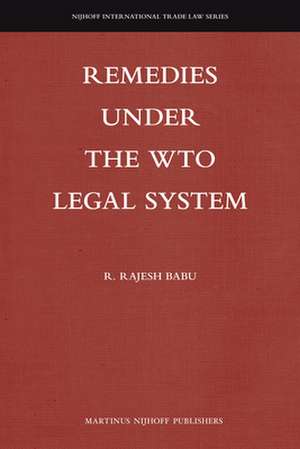Remedies under the WTO Legal System: Nijhoff International Trade Law Series, cartea 11
Autor R. Rajesh Babuen Limba Engleză Hardback – 24 iul 2012
Din seria Nijhoff International Trade Law Series
- 18%
 Preț: 953.97 lei
Preț: 953.97 lei - 18%
 Preț: 831.71 lei
Preț: 831.71 lei - 18%
 Preț: 759.38 lei
Preț: 759.38 lei - 18%
 Preț: 1090.34 lei
Preț: 1090.34 lei - 18%
 Preț: 907.01 lei
Preț: 907.01 lei - 18%
 Preț: 1114.69 lei
Preț: 1114.69 lei - 18%
 Preț: 778.52 lei
Preț: 778.52 lei - 18%
 Preț: 626.36 lei
Preț: 626.36 lei - 18%
 Preț: 920.84 lei
Preț: 920.84 lei - 18%
 Preț: 1329.22 lei
Preț: 1329.22 lei - 18%
 Preț: 626.71 lei
Preț: 626.71 lei - 18%
 Preț: 662.06 lei
Preț: 662.06 lei - 18%
 Preț: 733.07 lei
Preț: 733.07 lei - 18%
 Preț: 791.37 lei
Preț: 791.37 lei - 18%
 Preț: 790.90 lei
Preț: 790.90 lei
Preț: 1088.12 lei
Preț vechi: 1326.97 lei
-18% Nou
Puncte Express: 1632
Preț estimativ în valută:
208.24€ • 216.60$ • 171.91£
208.24€ • 216.60$ • 171.91£
Carte indisponibilă temporar
Doresc să fiu notificat când acest titlu va fi disponibil:
Se trimite...
Preluare comenzi: 021 569.72.76
Specificații
ISBN-13: 9789004209022
ISBN-10: 9004209026
Pagini: 500
Dimensiuni: 155 x 235 x 33 mm
Greutate: 0.93 kg
Editura: Brill
Colecția Brill | Nijhoff
Seria Nijhoff International Trade Law Series
ISBN-10: 9004209026
Pagini: 500
Dimensiuni: 155 x 235 x 33 mm
Greutate: 0.93 kg
Editura: Brill
Colecția Brill | Nijhoff
Seria Nijhoff International Trade Law Series
Notă biografică
R. Rajesh Babu, Ph.D. (2009) in International Law, Jawaharlal Nehru University, is Assistant Professor in the Public Policy and Management Group at the Indian Institute of Management, Calcutta. He has published several articles on the topic of international and WTO law.
Cuprins
Forward
Acknowledgement
Table of Contents
List of Abbreviations
I: INTRODUCTION
1. Introduction
2. Scope and Objective
3. General overview
II: GENERAL FEATURE OF THE WTO DISPUTE SETTLEMENT UNDERSTANDING
1. Introduction
2. GATT Dispute Settlement (1947-1994)
3. The WTO Dispute Settlement Understanding
4. Special and Additional Rules and Procedure for Dispute Settlement
5. Prohibition of Unilateralism
6. Jurisdiction
7. Other Means of Dispute Settlement in the DSU
III: REMEDIES UNDER INTERNATIONAL LAW
1. Introduction
2. Remedies in International Law in Context
3. The ILC Articles on State Responsibility for Internationally Wrongful Acts
4. Legal Consequences of the International Responsibility of a State
5. Conclusion
IV: REMEDIES UNDER THE WTO LAW
1. Introduction
2. Relationship between the WTO Law and the International Law
3. Nature of WTO Obligations: Bilateral or collective?
4. Access to the WTO Dispute Settlement: Legal standing
5. Material Aspects of Remedies under the WTO Dispute Settlement System
6. Implementation of Adverse DSB Rulings: The Procedural Aspect of Remedies
7. Compensation: Remedy for Non-Compliance
8. Remedies for Non-violation and Situation Claims
9. Preliminary Conclusions
V: ENFORCING REMEDIES UNDER WTO LAW
1. Introduction
2. Enforcement of Remedies in International Law
3. Applicability of Customary Rules of Countermeasures in WTO Law
4. Countermeasures in WTO Law
5. General Features of Countermeasure in The WTO
6. Principles and Procedure Governing Countermeasures
7. Level of Countermeasures: The Principle of Proportionality
8. Surveillance of Implementation
9. Instance of Countermeasures in the WTO: The Cases
10. The Effectiveness of Countermeasure in WTO Law
11. Preliminary Conclusions
VI: WTO REMEDIES AND THE DEVELOPING COUNTRIES
1. Introduction
2. Differential Treatment in International Law
3. The GATT 1947 and the Developing Countries
4. The WTO and the Developing Countries
5. WTO Remedies and the S&D Treatment for the Developing Countries
6. Interpretation by the Panel and Appellate Body: Bais against Developing Countries
7. Countermeasures and the Developing Countries
8. Preliminary Conclusions
VII: SUMMARY AND CONCLUSIONS
Acknowledgement
Table of Contents
List of Abbreviations
I: INTRODUCTION
1. Introduction
2. Scope and Objective
3. General overview
II: GENERAL FEATURE OF THE WTO DISPUTE SETTLEMENT UNDERSTANDING
1. Introduction
2. GATT Dispute Settlement (1947-1994)
3. The WTO Dispute Settlement Understanding
4. Special and Additional Rules and Procedure for Dispute Settlement
5. Prohibition of Unilateralism
6. Jurisdiction
7. Other Means of Dispute Settlement in the DSU
III: REMEDIES UNDER INTERNATIONAL LAW
1. Introduction
2. Remedies in International Law in Context
3. The ILC Articles on State Responsibility for Internationally Wrongful Acts
4. Legal Consequences of the International Responsibility of a State
5. Conclusion
IV: REMEDIES UNDER THE WTO LAW
1. Introduction
2. Relationship between the WTO Law and the International Law
3. Nature of WTO Obligations: Bilateral or collective?
4. Access to the WTO Dispute Settlement: Legal standing
5. Material Aspects of Remedies under the WTO Dispute Settlement System
6. Implementation of Adverse DSB Rulings: The Procedural Aspect of Remedies
7. Compensation: Remedy for Non-Compliance
8. Remedies for Non-violation and Situation Claims
9. Preliminary Conclusions
V: ENFORCING REMEDIES UNDER WTO LAW
1. Introduction
2. Enforcement of Remedies in International Law
3. Applicability of Customary Rules of Countermeasures in WTO Law
4. Countermeasures in WTO Law
5. General Features of Countermeasure in The WTO
6. Principles and Procedure Governing Countermeasures
7. Level of Countermeasures: The Principle of Proportionality
8. Surveillance of Implementation
9. Instance of Countermeasures in the WTO: The Cases
10. The Effectiveness of Countermeasure in WTO Law
11. Preliminary Conclusions
VI: WTO REMEDIES AND THE DEVELOPING COUNTRIES
1. Introduction
2. Differential Treatment in International Law
3. The GATT 1947 and the Developing Countries
4. The WTO and the Developing Countries
5. WTO Remedies and the S&D Treatment for the Developing Countries
6. Interpretation by the Panel and Appellate Body: Bais against Developing Countries
7. Countermeasures and the Developing Countries
8. Preliminary Conclusions
VII: SUMMARY AND CONCLUSIONS
